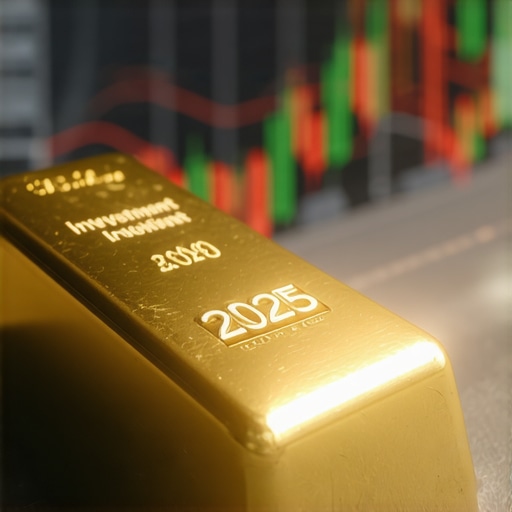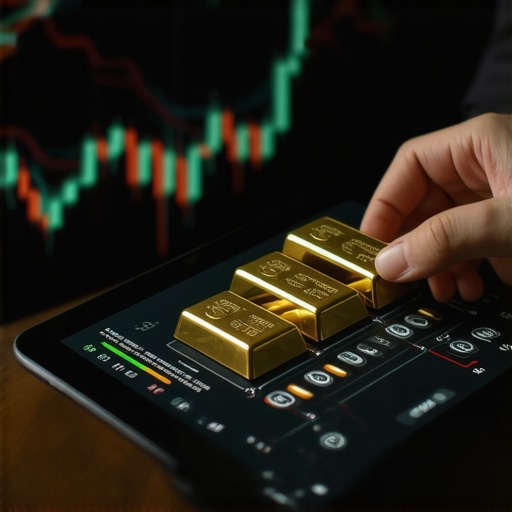Strategic Foundations: Why Gold Remains a Premier Inflation Hedge
In an era marked by persistent inflationary pressures and economic uncertainties, gold continues to assert itself as a quintessential asset for preserving wealth. Its intrinsic value, unlike fiat currencies, is less susceptible to erosion from inflation, making it a vital component of sophisticated investment portfolios aimed at hedging inflation risks. Understanding the nuanced mechanisms through which gold counters inflation requires an exploration of its supply-demand dynamics, market behavior, and diversification roles.
Advanced Portfolio Integration: Combining Physical and Paper Gold for Optimal Inflation Protection
Experienced investors recognize that a hybrid approach combining physical gold holdings—such as bars and coins—with financial instruments like gold ETFs and mutual funds can maximize inflation hedging efficacy. Physical gold provides tangible asset security and liquidity, while gold ETFs facilitate cost-efficient exposure and ease of trading. This dual strategy balances the risk of market volatility with the stability of physical ownership, a concept supported by recent analyses of gold demand trends and central bank purchasing patterns (understanding gold demand trends).
How Do Central Bank Gold Purchases Influence Inflation Hedging Strategies?
Central banks’ strategic gold acquisitions play a pivotal role in shaping global gold prices and, consequently, investment strategies. Their buying activity often signals concerns about currency depreciation and inflation, leading to price appreciation that benefits private investors. Monitoring these movements is critical for timing entry points and adjusting portfolio allocations. For a deeper dive, see how central bank gold purchases affect price volatility.
Leveraging Gold Mining Stocks and ETFs: Diversification Beyond Physical Holdings
While physical gold remains a core hedge, incorporating gold mining stocks and exchange-traded funds (ETFs) offers leveraged returns tied to operational efficiencies and commodity prices. These instruments provide exposure to gold’s inflation-hedging properties with the potential for dividends and capital gains, albeit with added market risks. Selecting high-quality mining stocks and balanced ETFs requires expertise in analyzing sector-specific risks and macroeconomic indicators.
What Are the Emerging Risks and Considerations in Gold Investment Amid Inflation?
Investors must navigate evolving challenges such as geopolitical shifts, fluctuating interest rates, and technological disruptions in mining. Additionally, understanding the liquidity constraints and authenticity verification of physical gold is paramount. Engaging with trusted dealers and employing secure storage solutions mitigates counterparty risk. For comprehensive strategies on physical gold investment security, consult physical gold investments: how to verify authenticity easily.
Call to Action: Elevate Your Expertise on Gold Investment Tactics
For investors aiming to refine their portfolio’s resilience against inflation, exploring advanced gold investment strategies and market analyses is essential. Engage with expert content such as best gold investment strategies to hedge economic uncertainty and contribute your insights to professional forums to stay at the forefront of this dynamic field.
External source: According to research published by the World Gold Council, gold’s role as a hedge against inflation is reinforced by its negative correlation with real interest rates and its safe-haven status during economic turmoil (World Gold Council – Inflation and Gold).
Harnessing Gold’s Role Amid Rising Real Interest Rates
As global economies grapple with shifting monetary policies, the interplay between real interest rates and gold’s inflation-hedging capabilities becomes increasingly complex. Historically, gold demonstrates a negative correlation with real interest rates, meaning when real rates rise, gold prices often face downward pressure. However, this relationship is nuanced by geopolitical tensions, currency fluctuations, and investor sentiment. Savvy investors should monitor these macroeconomic indicators closely, integrating insights from gold market trends and price drivers to anticipate price movements effectively.
Innovative Strategies: Utilizing Gold Derivatives for Inflation Hedging
Beyond traditional holdings, gold derivatives such as futures and options provide sophisticated avenues to hedge inflation risks with leveraged exposure and flexible risk management. These instruments enable investors to capitalize on anticipated price changes without the need for physical ownership, offering liquidity and strategic positioning. However, derivatives demand rigorous risk assessment and understanding of market mechanics. Integrating these with physical and paper gold assets can optimize portfolio resilience, especially during volatile inflationary periods.
How Can Investors Leverage Gold’s Safe-Haven Status During Geopolitical Uncertainty?
Gold’s reputation as a safe haven is well-earned, particularly during geopolitical crises that disrupt financial markets and elevate inflation fears. Investors often flock to gold to preserve capital when traditional assets falter. Understanding the timing and scale of such shifts requires expertise in geopolitical risk analysis and its intersection with gold demand. For example, recent tensions have accelerated central bank gold purchases, as detailed in analyses of central bank gold acquisition impacts. Incorporating geopolitical insights enables proactive portfolio adjustments, enhancing inflation hedging efficacy.
Integrating ESG Considerations in Gold Mining Investments
Environmental, Social, and Governance (ESG) factors are increasingly influential in gold mining investments. Investors seeking inflation protection through mining stocks or ETFs must evaluate companies’ ESG compliance, as it affects operational sustainability, regulatory risks, and long-term profitability. Mining firms with strong ESG credentials tend to attract premium valuations and exhibit resilience against reputational and regulatory shocks. Hence, ESG integration is not only ethically prudent but also strategically vital for mitigating inflation-related risks tied to mining sector volatility.
Emerging Technologies Shaping Gold Market Dynamics
Technological innovations, including blockchain for provenance verification and advanced extraction techniques, are redefining gold market transparency and supply chains. These advancements enhance investor confidence by reducing fraud risks and improving supply predictability. Furthermore, digital gold assets backed by verified physical reserves offer new inflation-hedging tools combining liquidity with tangible value. Staying abreast of these technological trends is essential for investors aiming to maintain a competitive edge in gold investment strategies.
External source: As reported by the International Monetary Fund, gold continues to serve as a crucial buffer against inflation shocks and financial instability, particularly when integrated with diversified asset strategies that account for evolving market and geopolitical conditions (IMF Working Paper on Gold and Portfolio Diversification).
Call to Action: Share Your Insights and Explore Advanced Gold Strategies
How are you adapting your gold investment approach to the latest inflation and geopolitical challenges? We invite you to share your strategies and questions in the comments below. For further expertise, explore our comprehensive resources on best gold investment strategies to hedge economic uncertainty and deepen your understanding of this dynamic asset class.
Quantitative Modeling of Gold’s Inflation Hedging Performance: Beyond Traditional Metrics
In the evolving landscape of inflation hedging, sophisticated investors are increasingly turning to quantitative models to dissect and predict gold’s price behavior relative to inflationary indicators. Traditional wisdom emphasizes gold’s negative correlation with real interest rates and inflation spikes; however, modern econometric techniques including vector autoregression (VAR) and machine learning algorithms provide deeper insights into lag effects, volatility regimes, and nonlinear dynamics.
These models enable portfolio managers to optimize gold allocations by simulating various inflation scenarios and their impact on gold price trajectories. For instance, advanced factor models incorporate macro variables such as commodity indices, currency movements, and geopolitical risk proxies, refining predictive accuracy. The integration of these tools allows investors to move beyond static heuristics and embrace dynamic, data-driven inflation hedging strategies.
How Do Emerging Econometric and AI Techniques Enhance Gold Inflation Hedge Forecasting?
Emerging econometric and AI-driven approaches empower investors to capture complex interdependencies between gold prices and inflation. Techniques like recurrent neural networks (RNNs) and reinforcement learning algorithms can model temporal dependencies and adapt to evolving market conditions, enhancing forecast precision. These methods accommodate nonlinearities and regime shifts often missed by classical linear models, thereby offering a granular understanding of gold’s response to multifaceted economic shocks.
Moreover, sentiment analysis powered by natural language processing (NLP) on financial news and central bank communications provides supplementary signals for gold price movements in inflationary contexts. Integrating these advanced analytics fosters proactive portfolio adjustments and mitigates tail risks associated with unexpected inflation accelerations.
Strategic Utilization of Gold-Backed Digital Assets and Tokenization in Inflation Hedging
As the financial ecosystem embraces digital transformation, tokenized gold assets and blockchain-based platforms are emerging as innovative vehicles for inflation protection. These digital gold representations often provide fractional ownership, enhanced liquidity, and transparent provenance verified through distributed ledger technology.
Tokenized gold facilitates seamless integration into decentralized finance (DeFi) applications, enabling investors to access collateralized lending, yield farming, and automated portfolio rebalancing with gold exposure. This convergence of traditional inflation-hedging assets and cutting-edge fintech solutions represents a paradigm shift, broadening access and flexibility while maintaining intrinsic value preservation.
However, the regulatory landscape and custody risks remain critical considerations. Investors should conduct meticulous due diligence on token issuers and underlying physical reserves to safeguard against counterparty and operational risks.
Assessing the Impact of Monetary Policy Divergence on Gold’s Inflation Hedge Efficacy
In a globally interconnected economy, divergent monetary policies among major central banks introduce complex dynamics affecting gold’s role as an inflation hedge. For example, when the Federal Reserve tightens policy aggressively while the European Central Bank maintains dovish stances, currency fluctuations and capital flows can distort gold pricing mechanisms.
Such divergence may temporarily decouple gold prices from domestic inflation trends, challenging investors relying on gold as a straightforward inflation proxy. Advanced portfolio strategies incorporate cross-currency hedging and multi-asset overlays to mitigate these effects, emphasizing the necessity of a global macroeconomic perspective.
Continuous monitoring of policy announcements, yield curve movements, and liquidity conditions is essential for timely adjustments. For rigorous analysis, the Bank for International Settlements provides comprehensive reports detailing monetary policy impacts on commodity markets (BIS Working Paper on Monetary Policy Divergence and Commodity Prices).
Call to Action: Explore Advanced Analytical Frameworks to Elevate Your Gold Inflation Hedging Strategy
To remain at the forefront of inflation risk management, deepen your expertise by integrating quantitative modeling, AI techniques, and emerging digital gold instruments into your investment toolkit. Engage with specialized research, participate in professional forums, and experiment with tailored hedging frameworks that reflect your unique risk appetite and market outlook. Discover more on advanced gold investment analytics to refine your approach.
Quantitative Modeling of Gold’s Inflation Hedging Performance: Beyond Traditional Metrics
In the evolving landscape of inflation hedging, sophisticated investors are increasingly turning to quantitative models to dissect and predict gold’s price behavior relative to inflationary indicators. Traditional wisdom emphasizes gold’s negative correlation with real interest rates and inflation spikes; however, modern econometric techniques including vector autoregression (VAR) and machine learning algorithms provide deeper insights into lag effects, volatility regimes, and nonlinear dynamics.
These models enable portfolio managers to optimize gold allocations by simulating various inflation scenarios and their impact on gold price trajectories. For instance, advanced factor models incorporate macro variables such as commodity indices, currency movements, and geopolitical risk proxies, refining predictive accuracy. The integration of these tools allows investors to move beyond static heuristics and embrace dynamic, data-driven inflation hedging strategies.
How Do Emerging Econometric and AI Techniques Enhance Gold Inflation Hedge Forecasting?
Emerging econometric and AI-driven approaches empower investors to capture complex interdependencies between gold prices and inflation. Techniques like recurrent neural networks (RNNs) and reinforcement learning algorithms can model temporal dependencies and adapt to evolving market conditions, enhancing forecast precision. These methods accommodate nonlinearities and regime shifts often missed by classical linear models, thereby offering a granular understanding of gold’s response to multifaceted economic shocks.
Moreover, sentiment analysis powered by natural language processing (NLP) on financial news and central bank communications provides supplementary signals for gold price movements in inflationary contexts. Integrating these advanced analytics fosters proactive portfolio adjustments and mitigates tail risks associated with unexpected inflation accelerations.
Strategic Utilization of Gold-Backed Digital Assets and Tokenization in Inflation Hedging
As the financial ecosystem embraces digital transformation, tokenized gold assets and blockchain-based platforms are emerging as innovative vehicles for inflation protection. These digital gold representations often provide fractional ownership, enhanced liquidity, and transparent provenance verified through distributed ledger technology.
Tokenized gold facilitates seamless integration into decentralized finance (DeFi) applications, enabling investors to access collateralized lending, yield farming, and automated portfolio rebalancing with gold exposure. This convergence of traditional inflation-hedging assets and cutting-edge fintech solutions represents a paradigm shift, broadening access and flexibility while maintaining intrinsic value preservation.
However, the regulatory landscape and custody risks remain critical considerations. Investors should conduct meticulous due diligence on token issuers and underlying physical reserves to safeguard against counterparty and operational risks.
Assessing the Impact of Monetary Policy Divergence on Gold’s Inflation Hedge Efficacy
In a globally interconnected economy, divergent monetary policies among major central banks introduce complex dynamics affecting gold’s role as an inflation hedge. For example, when the Federal Reserve tightens policy aggressively while the European Central Bank maintains dovish stances, currency fluctuations and capital flows can distort gold pricing mechanisms.
Such divergence may temporarily decouple gold prices from domestic inflation trends, challenging investors relying on gold as a straightforward inflation proxy. Advanced portfolio strategies incorporate cross-currency hedging and multi-asset overlays to mitigate these effects, emphasizing the necessity of a global macroeconomic perspective.
Continuous monitoring of policy announcements, yield curve movements, and liquidity conditions is essential for timely adjustments. For rigorous analysis, the Bank for International Settlements provides comprehensive reports detailing monetary policy impacts on commodity markets (BIS Working Paper on Monetary Policy Divergence and Commodity Prices).
Call to Action: Explore Advanced Analytical Frameworks to Elevate Your Gold Inflation Hedging Strategy
To remain at the forefront of inflation risk management, deepen your expertise by integrating quantitative modeling, AI techniques, and emerging digital gold instruments into your investment toolkit. Engage with specialized research, participate in professional forums, and experiment with tailored hedging frameworks that reflect your unique risk appetite and market outlook. Discover more on advanced gold investment analytics to refine your approach.
External source: As reported by the International Monetary Fund, gold continues to serve as a crucial buffer against inflation shocks and financial instability, particularly when integrated with diversified asset strategies that account for evolving market and geopolitical conditions (IMF Working Paper on Gold and Portfolio Diversification).
Expert Insights & Advanced Considerations
Dynamic Interaction Between Gold and Monetary Policy Divergence
Understanding how divergent central bank policies influence gold’s inflation-hedging efficacy is crucial. When major economies pursue contrasting monetary stances, the resulting currency and capital flow volatility can decouple gold prices from domestic inflation signals. Sophisticated investors integrate cross-currency hedging and macro overlays to navigate these distortions effectively, maintaining portfolio resilience amid global policy divergence. For in-depth analysis, explore how central bank gold purchases affect price volatility and related market dynamics.
Leveraging Quantitative and AI-Driven Models for Enhanced Forecasting
Advanced econometric techniques, including VAR and machine learning algorithms, allow investors to capture complex lag effects and nonlinearities in gold price responses to inflationary pressures. Incorporating sentiment analysis from central bank communications and financial news further refines these models. This integration enables proactive adjustments to gold allocations, optimizing inflation hedging strategies beyond traditional heuristics. Additional insights can be found in advanced gold investment analytics.
Innovations in Digital Gold Assets and Tokenization
The rise of blockchain-based tokenized gold assets introduces fractional ownership and enhanced liquidity, presenting novel inflation-hedging mechanisms. These digital instruments facilitate seamless integration into decentralized finance platforms, expanding strategic flexibility. Yet, they require rigorous due diligence concerning regulatory frameworks and reserve authenticity to mitigate operational risks. To explore these evolving vehicles, see physical gold investments: how to verify authenticity easily and related resources.
Integrating ESG Criteria in Gold Mining Investment Decisions
Environmental, Social, and Governance considerations increasingly shape the risk profile and valuation of gold mining equities and ETFs. Investors targeting inflation protection through mining exposure benefit from prioritizing companies with transparent ESG compliance, which contributes to operational resilience and mitigates reputational risks. For guidance on selecting mining stocks aligned with sound ESG practices, refer to choosing the best gold mining stocks for long-term gains.
Curated Expert Resources
- World Gold Council – Inflation and Gold: Authoritative research detailing gold’s correlation with inflation and real interest rates, providing foundational insights into gold’s role as a safe haven during economic volatility (gold.org).
- Bank for International Settlements (BIS) Working Paper: Comprehensive analysis of how divergent monetary policies impact commodity markets including gold, essential for understanding global macroeconomic influences (BIS Working Paper on Monetary Policy Divergence and Commodity Prices).
- International Monetary Fund (IMF) Working Paper: Explores gold’s portfolio diversification benefits amid inflation shocks and geopolitical risks, reinforcing strategic allocation considerations (IMF Working Paper on Gold and Portfolio Diversification).
- BuyingGoldNow.com – Advanced Gold Investment Analytics: Specialized resource offering quantitative modeling techniques and AI-driven forecasting tools tailored to gold inflation hedging strategies (advanced gold investment analytics).
- BuyingGoldNow.com – Gold Demand Trends and Market Price Drivers: In-depth insights into supply-demand dynamics and central bank purchase impacts that shape gold market fundamentals (understanding gold demand trends).
Final Expert Perspective
In navigating the complexities of inflation hedging, gold remains a multifaceted asset whose efficacy is influenced by an evolving interplay of monetary policies, technological innovation, and ESG considerations. Mastery of advanced quantitative analytics and a global macroeconomic lens enhances the strategic deployment of gold within diversified portfolios. Leveraging both traditional physical holdings and emerging digital gold assets can optimize protection against inflationary shocks, while attentiveness to geopolitical developments and market trends ensures timely adaptation.
We encourage seasoned investors and professionals to deepen their engagement with nuanced gold investment strategies by exploring the curated expert resources and contributing insights within specialized forums. Elevate your approach by integrating these advanced frameworks and remain at the forefront of inflation risk management.
For further exploration, consider our comprehensive analysis on gold market trends and price drivers as a next step in refining your portfolio’s inflation resilience.










